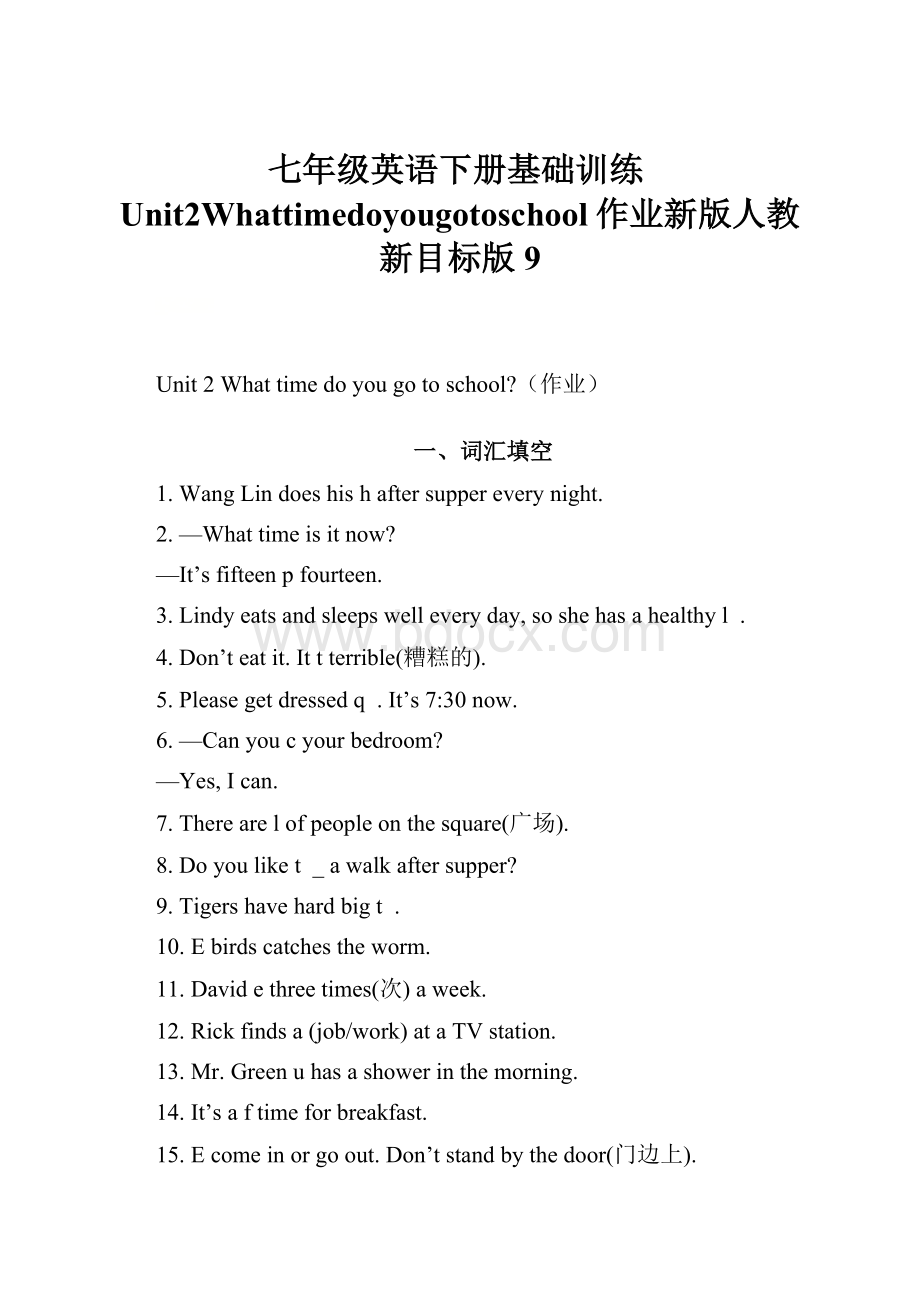七年级英语下册基础训练Unit2Whattimedoyougotoschool作业新版人教新目标版9Word文档格式.docx
《七年级英语下册基础训练Unit2Whattimedoyougotoschool作业新版人教新目标版9Word文档格式.docx》由会员分享,可在线阅读,更多相关《七年级英语下册基础训练Unit2Whattimedoyougotoschool作业新版人教新目标版9Word文档格式.docx(14页珍藏版)》请在冰豆网上搜索。

A.thingsB.homeworkC.houseworkD.maths
()23.Tonynevereatsvegetables,sohedoesn’thavea(n)life.
A.happyB.interestingC.healthyD.sad
()24.EitherthetwinsorWeiMingawalkeverynight.
A.takeB.takesC.totakeD.have()25.Hebought(买)ascarfforhismother’sbirthday.
A.fiftyB.fiftythC.fivetiethD.fiftieth
三、完成句子
26.Mymothermakesbreakfastat6:
30forme.(就划线部分提问)
?
27.JackhasatestonFridayafternoon.(就划线部分提问)
28.—Whattimedoyouhavebreakfast?
(根据实际情况用always,usuallyornever作答)
—
29.—?
(根
据答语用whattime或when写出问句)
—Annanevereatsbreakfast.
30.请根据括号中的提示词写问句和答语
A:
(you/usually/gettoschool)
B:
.(7:
30)
(yourclassteacher/usually/gettoschool)
Idon’tknow.Buthe/sheisneverlateforthefirstclassinthemorning.
【参考答案】
一、
1.homework
2.past
3.life
4.tastes
5.quickly
6.clean
7.lots
8.taking
9.teeth
10.Early
11.exercises
16.group
12.job
17.quarter
13.usually
14.funny
15.Either
二、
18-20CBD21-25CACBD
三、
26.Whattimedoesyourmothermakebreakfastforyou?
或Whendoesyourmothermakebreakfastforyou?
27.WhendoesJackhaveatest?
28.Iusuallyhavebreakfastat7:
00.
29.WhendoesAnnaalwayshavebreakfast?
30.Whendoyouusuallygettoschool?
或Whattimedoyouusuallygettoschool?
At7:
30.
Whendoesyourclassteacherusuallygettoschool?
或Whattimedoesyourclassteacherusuallygettoschool?
Unit9Whatdoeshelooklike?
(讲义)
Part1WordsandExpressions
curly/'
kɜː(r)li/adj.卷曲的
straight/streɪt/adj.直的
tall/tɔːl/adj.高的medium/'
miːdiəm/adj.中等的height/haɪt/n.身高;
高度(be)ofmediumheight中等身高thin/θɪn/adj.瘦的
heavy/'
hevi/adj.重的
build/bɪld/n.身材
(be)ofmediumbuild中等身材
tonight/tə'
naɪt/adv.&
n.(在)今晚;
(在)今夜
little/'
lɪtl/adj.小的
alittle一点;
少量cinema/'
sɪnəmə/n.电影院glasses/'
glɑːsɪz/,/'
glæ
sɪz/(pl.)n.眼镜later/'
leɪtə(r)/adv.以后handsome/'
hæ
nsəm/adj.英俊的
actor/'
æ
ktə(r)/n.演员actress/'
ktrəs/n.女演员person/'
pɜː(r)sn/n.人nose/nəʊz/n.鼻子
blonde/blɒnd/adj.(blond)(头发)金黄色的
mouth/maʊθ/n.嘴
round/raʊnd/adj.圆形的
face/feɪs/n.脸
eye/aɪ/n.眼睛
singer/'
sɪŋə(r)/n.歌手
artist/'
ɑː(r)tɪst/n.艺术家
crime/kraɪm/n.犯罪活动
criminal/'
krɪmɪnl/n.罪犯
put/pʊt/v.放
each/iːtʃ/adj.&
pron.每个;
各自
way/weɪ/n.方式;
路线
describe/dɪ'
skraɪb/v.描述
differently/'
dɪfərəntli/adv.不同地
another/ə'
nʌð
ə(r)/adj.&
pron.另一;
又一
end/end/n.结尾;
尽头
intheend最后
real/rɪəl/adj.真正的;
真实的
jeans/dʒiːnz/n.牛仔裤Johnny/'
dʒɒni/约翰尼(男名)Dean/diːn/迪安(姓)
Tina/'
tiːnə/蒂娜(女名)Jackson/'
dʒæ
ksən/杰克逊(姓)
putv.放
Pleaseputthebookonthedesk.Don’tputthecupinthebox.
Thepoliceputapictureofthecriminalinnewspapers.
putsth.in/on/under…
Daisy,putonyourcoat!
It’scoldtoday.Putyourcoaton!
Iwanttoputmyglasseson.Ican’tseeit.Iwanttoputonmyglasses.
eachadj.&
18.adj.+n.
eachpersoneachcriminal
Eachstoryinthisbookisveryscary.
19.pron.单独使用
eachofthestudents
Eachofthechildrengetsacake.each&
every
29.Eachchildgetsasmallgift.每个孩子都得到了一件小礼物。
Everychildgetsasmallgift.所有的孩子都得到了一件小礼物。
each强调,every则强调。
30.eachofthecriminal正确
everyofthecriminals错误
anotheradj.&
adj.&
pron.
用法:
接,或者
31.adj.
Canyoushowmeanotherjacket?
Ifitdoesn’twork,youshouldfindanotherway.
32.pron.
—Ican’tfindmypencil.—Don’tworry,here’sanother.Idon’tlikethismovie.Let’sgotoseeanother.
Part2Role-play
Role-playtheconversation.
Mike:
Hi,Tony.Areyougoingtothemovietonight?
Tony:
Yes.We’remeetingatseven,right?
Yeah,butImaybealittlelate.MyfriendDavidisgoing,too.
Justmeethiminfrontofthecinemafirst.
Tony:
Oh,butIdon’tknowhim.Whatdoeshelooklike?
Mike:
Well,hehasbrownhairandwearsglasses.
OK.Ishetallorshort?
Heisn’ttallorshort.He’sofmediumheight.Tony:
OK,sure.Seeyoulaterthen.
Yeah,butImaybealittlelate.
Iamlate.
may为情态动词,意为“可能”,后接。
am/is/are的原形为be。
Heisamiddleschoolstudent.
Well,hehasbrownhairandwearsglasses.
Ourteacheriswearingaredshirttoday.
wear可翻译为“穿着,戴着”
常用一般现在时表示经常的状态,用进行时态表示暂时的状态。
Mostmiddleschoolchildrenuniformsatschool.
A.wearB.arewearing
C.putonD.areputtingon
对比:
wear强调一种状态,puton强调一个动作。
Myfatherhiscoatandthengoesout.
Part3GrammarFocus
—Whatdoeshelooklike?
—He’sreallytall.
—Whatdoesshelooklike?
—Shehaslongstraighthair.
—Whatdotheylooklike?
—They’reofmediumbuild.
—Dotheyhavestraightorcurlyhair?
—Theyhavecurlyhair.
—Ishetallorshort?
—Heisn’ttallorshort.He’sofmediumheight.
Whatdo/does…looklike?
“„„长得怎么样?
”,是询问某人外貌的句型。
他们长什么样?
你的新老师长得怎么样?
注意描述外貌时要使用不同的动词。
练习:
Writethesewordsinthecorrectbox.
shorthair
heavy
curlyhair
thin
ofmediumbuild
tall
straighthair
short
longhairofmediumheight
i
h
翻译:
Mary个子很高。
她中等身材。
她有一头长发。
Circlethecorrectwordstocompletetheconversation.A:
Sowhatdo/doesyourfriendClarklooklike?
Well,heis/hasthin,andhehave/hasblackhair.
Really?
Is/Doeshetallorshort?
Heis/isn’ttallorshort.Heis/hasofmediumbuild.A:
Doeshehas/havecurlyorstraighthair?
Heis/hasstraighthair.Andheis/hasreallyhandsome.
Dotheyhavestraightorcurlyhair?
Ishetallorshort?
DoyoulikeEnglishorChinese?
:
说话人提出两种或两种以上情况,问对方选择哪一种,两个选项用or连接。
语调。
回答时,不用yes或no,而是做出具体回答。
—IlikeEnglish.
Part4Reading
AnInterestingJob
JoeBrownhasaveryinterestingjob.Heisapoliceartist.SomepeopleseecrimesandthentalktoJoe.Theytellhimwhatthecriminallookslike.ThenJoedrawsapictureofthecriminal,andthepoliceputitinnewspapersandontelevisiontofindhim.
Hewantstodrawagoodpictureofeachcriminal,butthisjobissometimesdifficult.Manypeopledon’talwaysseethingsthesamewaysotheymaydescribethesamepersondifferently.Also,theydon’talwaysrememberwell.“Thecriminalisofmediumbuildandyoung.Hehaslongstraightbrownhairandbigeyes,”saysonewoman.Anotherwomansays,“Heistallandthin,andhehascurlyblondhair.He’saboutthirtyyearsold.”Intheend,therealcriminalisashortandheavyoldman,andhehasshortblackhair!
ThenJoedrawsapictureofthecriminal,andthepoliceputitinnewspapersandontelevisiontofindhim.
在报纸上
我在报纸上读到一篇好故事。
在电视上
HeonlywatchessportsonTV.
Also,theydon’talwaysrememberwell.
当also用于句首时,其后往往有逗号与句子的其他部分隔开,用于修饰整个句子,相当于“”。
Mr.Feng’sclassisinteresting.Also,hemakesiteasytounderstand.
also亦常表示“”,位于句子中之后,
之前。
MyfathercanspeakEnglish.HecanalsospeakFrench.
Jane’sbrotheristwelve.Hersisterisalsotwelve.Theyaretwins.
他留有长长的棕色直发。
英语中,当名词有两个以上的形容词修饰时,这些形容词通常遵循一定的顺序排列。
thelovely5-year-oldChinesegirl
aquietbigoldgreyBritishwoodenhousethe/my/this/twobeautiful/lovely…big/short…old/new/5-year-old…grey/white…British/Chinese…wooden…
*多个形容词顺序:
一个红色的大苹果
那个新的红色的羊毛长款毛衣
Part5Exercises
1.Ithinkmyfatherisa_(really)hero.
2.TheAmericanslookatlife(different)fromtheChinese.
3.XuBeihongisagreat(art).Heisgoodatdrawing.
4.Look!
Themanisofmedium(high)andhaslonghair.
5.Ginaalwayswearsapairof(jean).
6.Doesyourfatheroftenwearapairof(glass)?
()7.—Whathelike?
—He’stallandthin.
A.is;
lookB.does;
look
C.does;
looksD.do;
look()8.WhatMaryandhersisterlooklike?
A.doB.doesC.isD.be()9.—Whatdoesyourfriendlooklike?
—
A.Sheisverykind.B.Sheisfine.
C.Sheisofmediumbuild.D.Shelikesblueshirt.()10.Thelittlegirlbeautifullongblackhair.
A.isB.hasC.withD.have()11.—Isheheavy?
—No.Heiskindof.
A.tallB.thinC.shortD.heavy()12.Sheshortandshemediumbuild.
A.has;
isB.is;
isC.has;
hasD.is;
isof()13.Therearefiveintheroom.
A.peopleB.peoplesC.personD.boy()14.Healways_whiteshoes.
A.inB.haveonC.wearsD.putson()15.OurnewEnglishteacherhashair.
A.blacklongbeautifulB.beautifullongblack
C.long